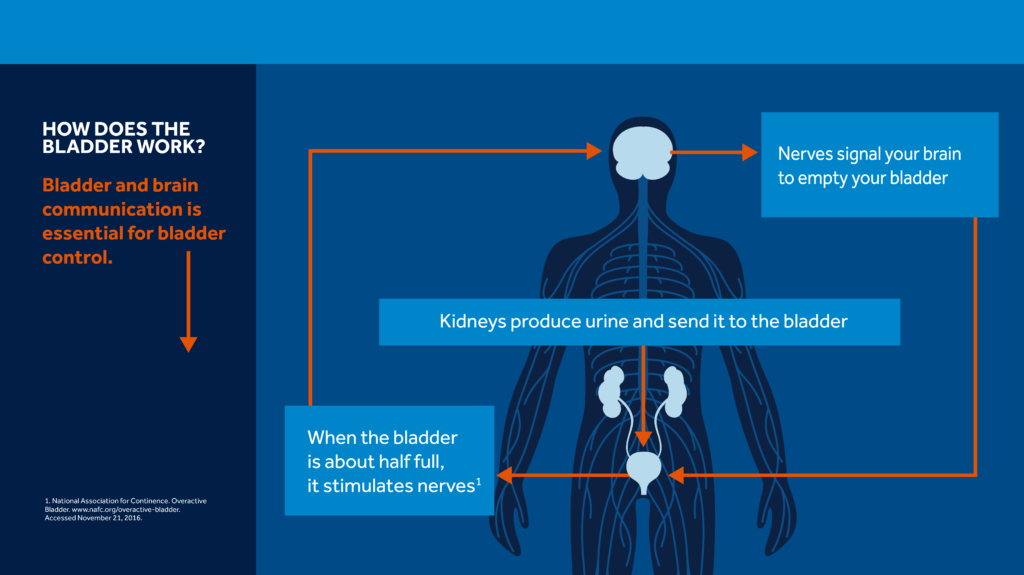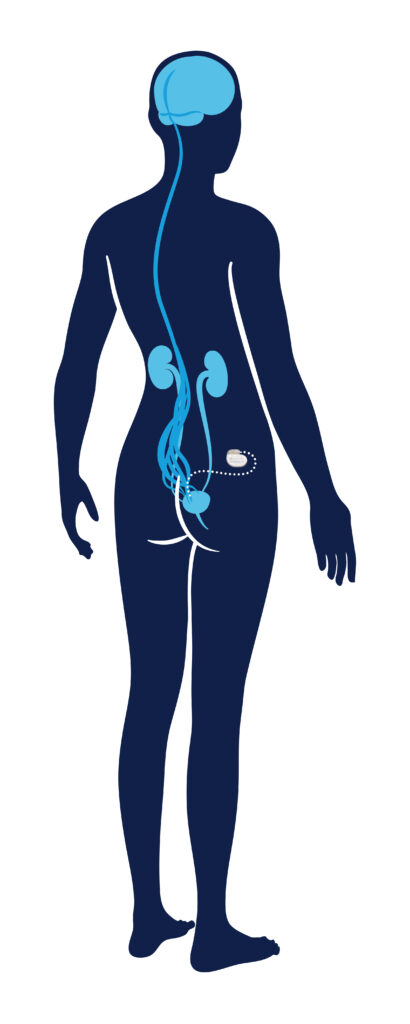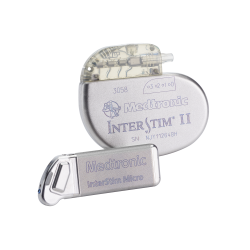Sacral Nerve Stimulation - InterStim Therapy
What is a Sacral Nerve Stimulator?
Sacral nerve stimulation therapy is an advanced treatment for patients with bowel and bladder control problems in whom more conservative treatments have not worked. It is often considered a “third-line” therapy meaning it is reserved for patients who have not found relief in “first line” therapies (diet and lifestyle changes, kegel exercises, physical therapy) or “second line” therapy (medications). It is used for the treatment of overactive bladder, urinary incontinence, fecal incontinence, and urinary retention.
What Does Sacral Nerve Stimulation Treat?
Overactive Bladder
Overactive bladder is a group of symptoms characterized by urinary frequency (going too often), urinary urgency (a sudden urge to pee that is difficult to suppress), and sometimes urinary incontinence associated with that sense of urgency. If more conservative measures (like pelvic floor exercises and medications) have not helped, then InterStim therapy may be a good next step.
Urinary Incontinence
Urinary incontinence is the involuntary loss of urine. InterStim is a treatment for loss of urine that follows a sudden urge to void. It is important to know that this reversible treatment helps many women with urge urinary incontinence, it does not work for stress incontinence and will only help the “urge” portion of mixed incontinence.
Fecal Incontinence
This type of incontinence is the involuntary loss of stool. It’s sometimes called bowel incontinence or incontinence of stool and is a life-altering condition due to the embarrassment it causes. Sacral nerve stimulation is one of the best treatments for certain types of fecal incontinence.
Urinary Retention
Urinary retention, an inability to completely empty the bladder, often responds well to sacral neuromodulation. Determining the type of urinary retention is critical to predicting the success of this treatment for urinary retention.

How is the Device Placed?
Implanted electrical stimulation devices are placed as part of a two step process. These steps are known as “stages” and can be considered a sort of “try before you buy” approach.
In the first stage, thin wires are placed through the skin of the low back, near the tailbone. These wires are then connected to an external batter pack “pulse generator” that is about the size of three stacked quarters.
This generator, connected to the wires, is worn on the outside of the body for about a week while the patient monitors symptoms using a diary. This diary will help determine how well the device worked for this particular patient’s symptoms and, ultimately, help determine if the more permanent generator (under the skin) should be placed.
If the device doesn’t work after the trial period (stage 1), the wires are simply removed. If it does work, and the patient wants to proceed with the implantation of the generator (battery pack), then the small wires are buried under the skin and the generator is placed through a small incision under the skin (and some fat) of the buttock. There will be a scar on the buttock, at the implant site, between one-half and two inches long.
After the device is placed and turned on, many patients do not need to make frequent adjustments to the it. If necessary, the electrical stimulation can be adjusted to minimize the symptoms commonly associated with bladder control problems or bowel control problems – such as urge incontinence, overactive bladder syndrome, or fecal incontinence.
Is InterStim the Only Sacral Nerve Stimulator?
No. InterStim was the first bladder stimulation device to reach the US market and has been available (and widely used) for many years. In the last few years a competitor has entered the market,the Axonics® System, and is an FDA-approved sacral neuromodulation solution for the treatment of bladder control problems and fecal incontinence.
What is Percutaneous Tibial Nerve Stimulation?
Percutaneous tibial nerve stimulation is a similar, but much less invasive type of electrical stimulation therapy for bladder and bowel dysfunction. It is an external device that sends electrical current without surgery. It involves the placement of a small accupuncture needle just above the ankle bone. A small, battery-powered generator is then attached to the needle and a mild electric current is passed through a nerve in the leg (the posterior tibial nerve) to the spinal cord where some of the signal spills over onto the sacral nerves that control the bladder and bowel.
Other names for this type of electrical stimulation are:
- Posterior tibial neuromodulation (PTNM)
- Percutaneous tibial neuromodulation (PTNM)
- Posterior tibial nerve stimulation (PTNS)
- Percutaneious tibial nerve stimulation (PTNS)
No matter the name, this type of electrical stimulation therapy is a good treatment option for patients who have not had adequate relief of their bowel and bladder control symptoms with less invasive treatments such as:
- Diet and lifestyle modifications
- Behavioral therapy
- At home pelvic floor exercises
- Physical therapy with or without biofeedback
- Medications
Studies suggest that this therapy is most successful when carried out for thirty minutes, once per week, for twelve weeks.
Frequently Asked Questions About Sacral Nerve Stimulation
What does sacral nerve stimulation do?
When it comes to bowel and bladder function, the sacral nerve plays an integral role. Interstim therapy works by sending mild electrical pulses to these nerves, thereby changing the signals that they send to the bladder, bowel, and pelvic floor.
How successful is InterStim Therapy?
For many patients the names, device history, and even details of device placement don’t matter. What they really want to know is, “how well does an electrical stimulator work?” Because the devices have been around for a number of years, there is considerable evidence to say that it works quite well – even after it has been used for several years.
Most commonly, “success” is defined by a 50% improvement in symptoms. Given this definition, rates of success for several conditions are outlined below.
- urge incontinence: 80% success at one year and ~60% success after 3 years with about half of patients having NO leakage episodes.
- bladder control (urinary urgency and frequency): ~60% success after 2 years.
- urinary retention: 70% success after 1.5 years. [1]
- incontinence of feces: 90% success with 40% of patients completely continent [2]
Conclusion
While the definition of success with this therapy varies from person to person, InterStim therapy is a treatment worthy of consideration for patients with bowel or bladder control issues. Clearly, the decision to undergo surgery, minor or otherwise, to get an implanted device is a big decision.
No matter if you’re in search of a therapy that controls bladder signals or you need help with bowel function, we’re happy to discuss the many treatment options available to you. Schedule an appointment today and let us work with you to build a treatment pathway designed to fit your goals.


